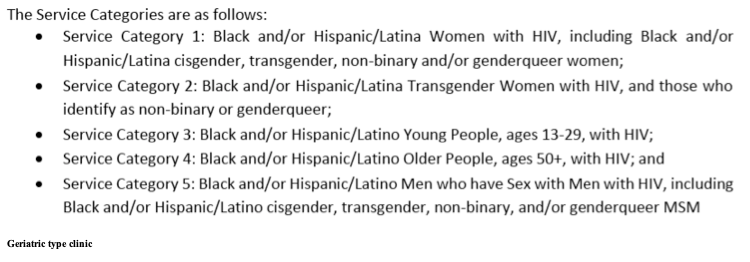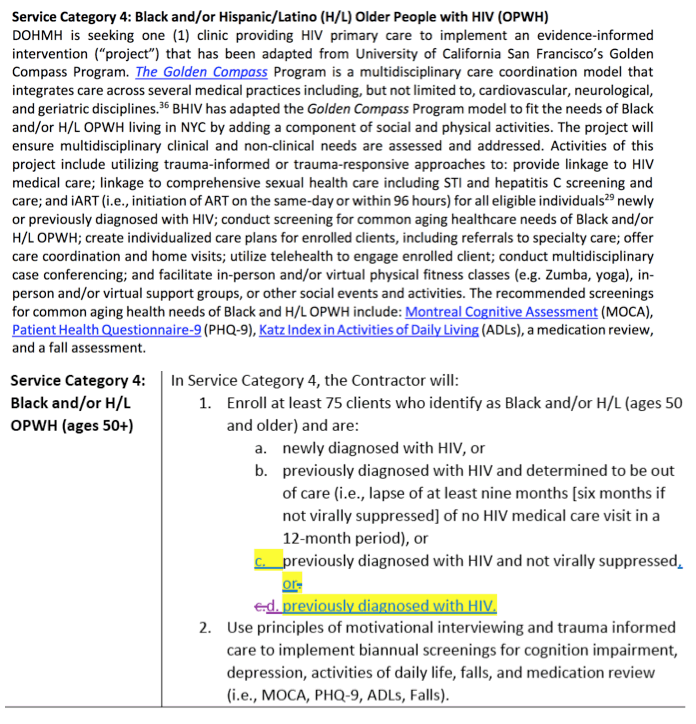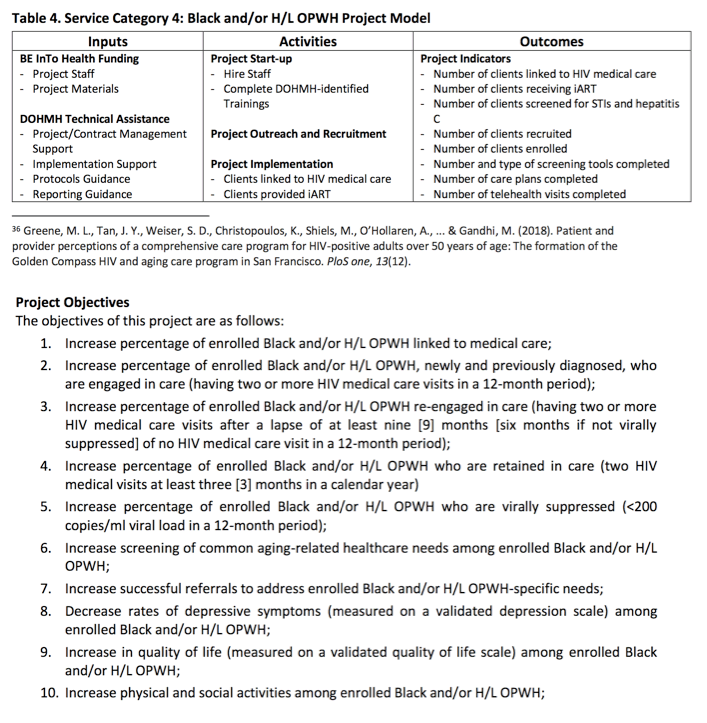| |
New NYC Funding for Care & Services for Black & Latino Older PLWH - Geriatric Clinic - Men & & Women, Transgender, Young - 5 Service Categories, including Hepatitis C
|
| |
| |
Download the PDF here
During the 2019 State of the Union address, the Trump administration announced the new "Ending the HIV Epidemic: A Plan for America." This is a ten-year initiative, beginning in Fiscal Year 2020, to achieve the important goal of reducing new HIV infections to less than 3,000 per year by 2030. BHIV is a recipient of funding for the Ending the HIV Epidemic (EHE): A Plan for America - Ryan White HIV/AIDS Program (RWHAP) Parts A and B as administered by the Health Resources and Services Administration (HRSA). ....
The EHE plan focuses on four strategies: Pillar One - diagnose all people with HIV as early as possible; Pillar Two - treat people with HIV rapidly and effectively to reach sustained viral suppression; Pillar Three - prevent new HIV transmissions by using proven interventions, including pre-exposure prophylaxis (PrEP) and syringe services programs (SSPs); and Pillar Four - respond quickly to potential HIV outbreaks to get needed prevention and treatment services to people who need them.1
With funds from this initiative, BHIV will focus on EHE Pillars Two and Four, treat and respond, by partnering with clinical agencies throughout NYC to implement effective strategies to reduce HIV transmission and improve HIV care outcomes.
To respond to these inequities, BHIV is launching a new program: Building Equity: Intervening Together for Health (BE InTo Health). This program will select up to five (5) contractors to implement one (1) of five (5) evidence-based interventions that will respond to the unique needs of one (1) priority population. Effective, evidence-based strategies exist that have been shown to improve health outcomes for those most vulnerable and critical in the fight to end the HIV epidemic. The evidence-based interventions proposed in this Request for Proposals (RFP) have been modified to respond to the unique needs of the NYC populations and include strategies that aim to improve engagement and re-engagement in care, initiation of immediate of antiretroviral treatment (iART), coordination of care, and ultimately, HIV outcomes among priority populations. This RFP has grouped the priority populations into five “Service Categories” based on the original design of the evidence-based interventions as well as the formative information collected from NYC stakeholders.



Black and/or Hispanic/Latina (H/L) Women with HIV, including Black and/or H/L cisgender, transgender, non-binary and/or genderqueer women
Black and H/L women are disproportionately affected by the HIV epidemic in the United States (U.S.), accounting for 75% of new HIV diagnoses among women in 2018.6 In NYC, in the same year, Black and H/L women made up 25% of the total population of PWH in the city with Black women accounting for 16%.7 In 2018, Black and H/L women also accounted for approximately 90% of new HIV diagnoses among women in NYC - with Black women experiencing a diagnosis rate 3.2 times higher than H/L women and 11 times higher than White, Asian Pacific Islander and multiracial women in 2018.8 Of those diagnosed and living with HIV, Black and H/L women often experience worse health outcomes related to the continuum of care with lower rates of engagement and retention in care and viral load suppression (VLS) in comparison to White women.9 The disproportionate impact of social determinants of health, including poverty, low health literacy, reduced access to high quality HIV services, stigma among healthcare providers, and racism and other systems of oppression create and exacerbate HIV care continuum health inequities among Black and H/L women, such as engagement and retention in care, treatment and VLS.10 11 Interventions to improve outcomes along the HIV care continuum for Black and/or H/L women should include activities that enhance health literacy and self-efficacy in managing their own care; and increase access to social support and supportive services (e.g., child care, access to testing for sexually transmitted infections [STIs], etc.).
Black and Hispanic/Latino (H/L) Older People with HIV (OPWH)
As advancements in treatment and care have enabled PWH to live healthier and longer lives, OPWH (ages 50 years and above) are a growing demographic of PWH across the U.S. This is no more evident than in NYC, where OPWH accounted for 58% of the total population of PWH in 2018.23 In NYC, OPWH achieved the highest rates of viral suppression compared to younger subgroups; however, racial and ethnic disparities among new diagnoses and concurrent AIDS diagnoses among OPWH must be addressed. In 2018, among all people 50 years and above, Black people had higher rates of HIV diagnoses than any other race or ethnicity. The proportion of concurrent HIV/AIDS diagnoses was also higher among Black people (35%) and H/L people (31%) ages 50 years and above than among White people (29%) and Asian Pacific Island people (23%).24 Furthermore, death rates among Native American, Multiracial and Black PWH ages 50 years and above were higher than rates for PWH 50 years and above of other race and ethnicities. 25 Aging with HIV comes with unique challenges. While OPWH tend to have better HIV care outcomes when compared to other age groups, they must deal with the effects of aging, including comorbidities, polypharmacy, social isolation, and depression.26 Consequently, care can become increasingly specialized and fragmented for OPWH, and the need for greater care coordination and management is critical to ensure comprehensive healthcare is received. Reductions in social supports, mobility, and other forms of physical and cognitive function; and increasing isolation, due to the loss of friends and partners can also impact morbidity, mortality, and the utilization of services among OPWH, which in turn can jeopardize HIV-related outcomes.27 Health outcomes among Black and/or H/L OPWH could be improved and protected through screening, addressing, and referring for common conditions and unmet needs associated with aging; multidisciplinary care coordination; social and physical activities; and frequent communication with HIV care teams.
A. Service Category Descriptions
BE InTo Health is designed for clinical agencies that provide HIV primary care and treatment to priority populations that operate out of a static clinic in the Bronx, Queens, Manhattan, or Brooklyn. DOHMH seeks contractors that have experience providing HIV care and treatment services and aim to expand the capacity of their agency to provide services to members of the identified priority populations. This is a new funding opportunity and does not replace any current BHIV funding opportunities. The selected contractors must provide HIV primary care and submit proof of one (1) of the following accreditations:
1. Article 28 (https://www.health.ny.gov/facilities/hospital/regulations/)
2. AIDS Clinical Trials Unit
(https://www.niaid.nih.gov/research/aids-clinical-trials-group)
3. Federal Qualified Health Center (FQHC)
(https://www.hrsa.gov/opa/eligibility-and-registration/health-centers/fqhc/index.html)
4. FQHC-Look Alike
(https://www.hrsa.gov/opa/eligibility-and-registration/health-centers/fqhc-look-alikes/index.html)
5. New York State Patient-Centered Medical Homes
(https://www.health.ny.gov/technology/nys_pcmh/
https://www.health.ny.gov/technology/innovation_plan_initiative/pcmh/)
6. Joint Commission Accreditation
(https://www.jointcommission.org/en/accreditation-and-certification/)
7. Designated AIDS Center
(https://profiles.health.ny.gov/hospital/designated_center/AIDS+Center)
|
|
| |
| |
|
|
|